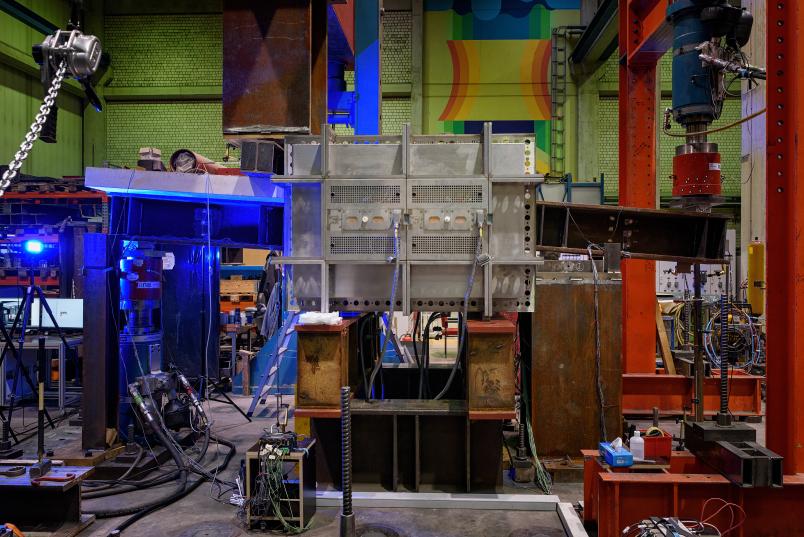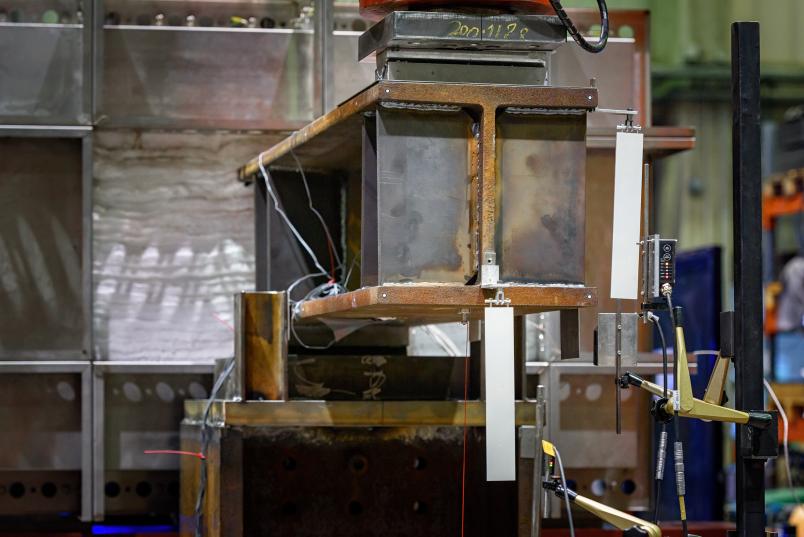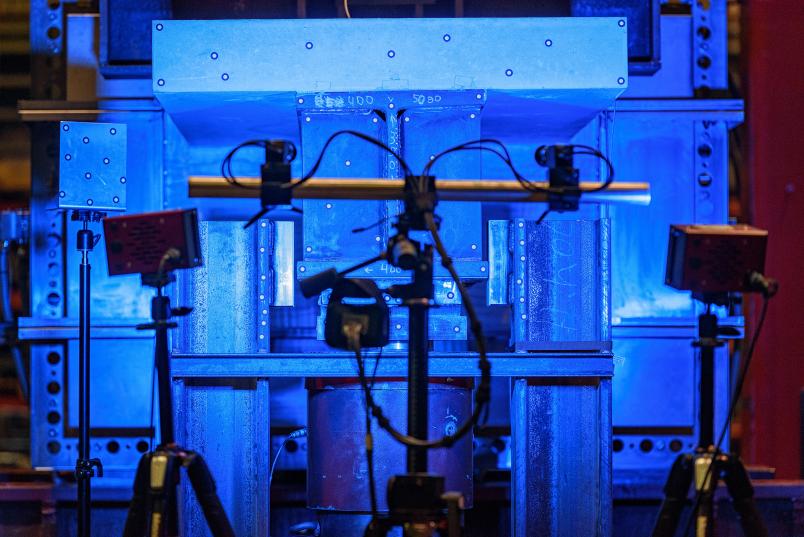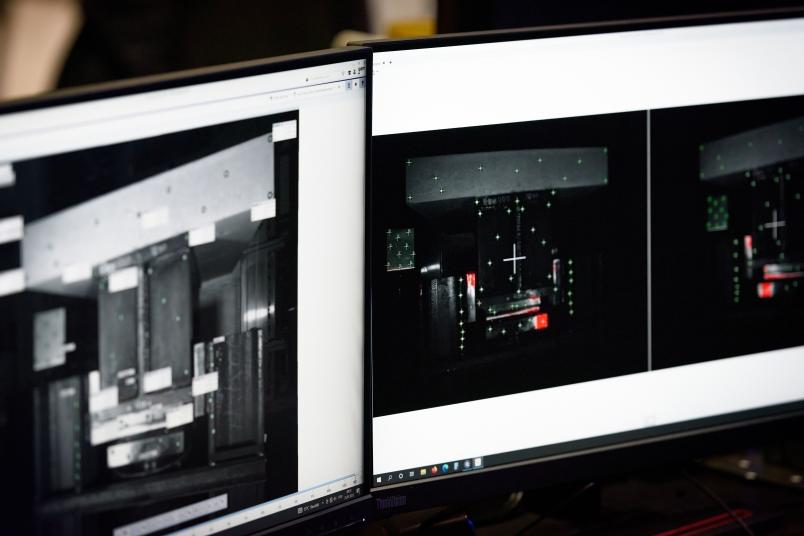
Composite construction Bridge girders in the oven
When concrete and steel stick together, they may be able to withstand extreme heat far longer than each of them can on their own. This is relevant when planning fire protection in building construction.
When under a bridge a fire breaks out, as it was the case in September of 2020 on the A40 highway in Mülheim, the whole structure is at great risk: the heat can rapidly rise to several hundred degrees Celsius. Steel girders can’t withstand it for long; the structural components fail: after a truck that transported fuel caught fire in Mülheim, three railway bridges had to be demolished.
“The primary concern is, of course, that no one is harmed during such incidents,” stresses Mehmed Numanović. “That’s why there are standards for the construction of bridges, as well as high-rise buildings and similar edifices, which specify how long a structure must withstand such heat in the event of a fire, so that everyone can get to safety.” In a project funded by the German Research Foundation, the PhD student at the Chair of Steel, Lightweight and Composite Structures is researching the principles of the load-bearing capacity of steel-concrete structures in order to optimise the standard.
Concrete shares the load
The main question is to what extent the concrete contributes to the heat resistance of the building. “To date, technical analyses have mainly focused on steel girders,” points out Mehmed Numanović. They are made up of metal sheets of varying thicknesses, which feature stiffeners at certain intervals that stabilise them and sub-divide them into individual sections. The girders run lengthwise and/or crosswise underneath the bridge and are mounted on its supporting piers. The concrete deck of the bridge is supported on the girder. The deck is fixed to the steel girder at short distances with shear studs. “Because they are so firmly connected, the steel girders don’t have to bear the full weight of the concrete deck; rather, it supports itself, as well,” as Mehmed Numanović illustrates: “Picture it like a stack of paper: if you glue together individual sheets of paper, they support a load as a solid unit rather than as individual sheets.”
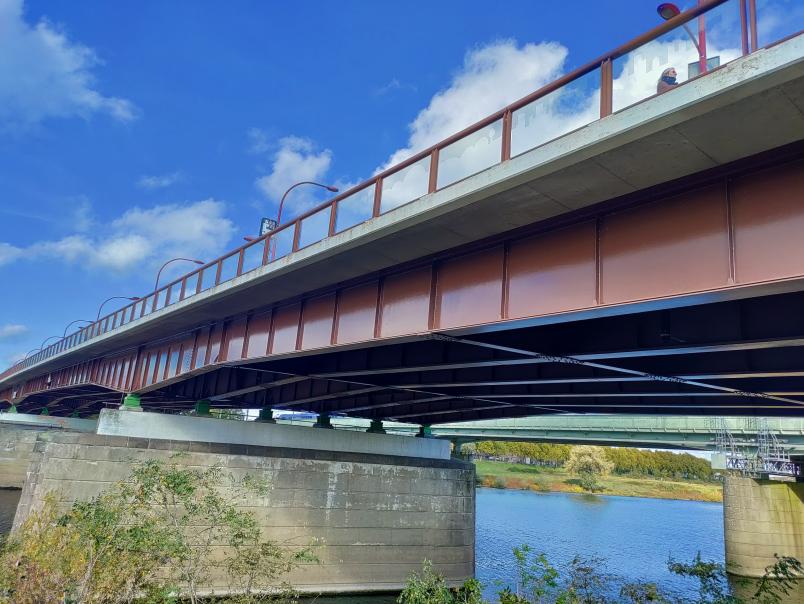
The project team has set up a large test rig in a structural laboratory in order to determine which role the concrete slab plays in the process. At its centre is an electric modular oven that can be flexibly adapted and generate heat of up to 1,200 degrees Celsius. The test objects are placed inside this oven: steel-concrete girder structures of different compositions, with a length of 7.2 metres and a height of one metre. “They are identical to the girders that are installed in real bridges and skyscrapers,” says Mehmed Numanović.
Test girders clamped into place
The girders are clamped into the test rig from above and below, with loads applied at girders’ ends and supports placed in-between: on one side, girders are supported by a large frame and a cylinder pushes the girders up from below. On the other side, they sit on a support structure and are pushed downwards by the means of the second cylinder. “We do it like this, because this setup enables us to explicitly study the forces we are interested in,” explains Mehmed Numanović. The oven sits in the middle. It applies heat from both sides and from below. When studying the structural failure of such a girder, the most interesting aspect is determining at which point significant displacements occur in it. This happens within the sections reinforced by transverse stiffeners, the so-called shear panels. The characteristic deformation that leads to failure is therefore called shear buckling. “If we were to apply stress to the girder only from above, bending forces would inevitably come into play. It would require quite a lot of effort to factor them out and, as a consequence, it would be more difficult to interpret our results,” explains Mehmed Numanović.
With their experiments, the researchers are trying to answer the following questions: (a) which loads can the steel-concrete composite structure sustain before it fails and (b) which temperature can be achieved before failure is established? “We have this information for steel alone,” says Mehmed Numanović. “At temperatures of 400 degrees and above, its stiffness and strength decrease.” Concrete has a more insulating effect than steel; it expands likewise, but the question remains as to how it interacts with steel in the event of a fire. To find this out, the team will put twelve different test girders under stress at and apply heat to them until they fail. The girders differ, for example, in the thickness of the steel sheets as well as in the number and spacing of the transverse stiffeners and shear studs joining them to the concrete deck.
The results are to be incorporated into a numerical model with which the load-bearing capacity of such girder structures can be calculated. Engineers should then be able to use a tool based on this model to configure their structure in conformity with the standards. Different target values apply to different types of structures; they are expressed as the length of time the respective structure must be able to withstand fire. In order to meet these targets, it’s possible to adjust a number of different parameters. After all, the aim is to always build in a cost-effective and material-saving way.
“It’s conceivable that the steel girders used to date are actually oversized, because they’ve always been designed without taking the effect of the concrete deck into account,” says Mehmed Numanović. The tests will show whether this is true and whether it will be possible to streamline the planning of steel structures for bridges and high-rise buildings without running any safety risks.
